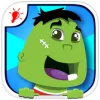Take a look inside 4 images
Wonster Words (Pro Edition) - spelling with ABC phonics by Puzzling
Pros: Gameplay focuses on phonics and common sounds in words.
Cons: Pricey. Kids don't have to assemble letters in the correct order.
Bottom Line: Silly graphics and some odd defining sentences sometimes distract from a respectable teaching approach.
Use Wonster Words (Pro Edition) - spelling with ABC phonics by Puzzling with beginning readers to give them some interactive activities that demonstrate how letters and letter combinations make sounds and how sounds make words. Teachers can point kids to a particular word group for individual play, then extend learning with whole-class or small-group activities. For instance, have kids explore new vocabulary words by using them in a story. Or, generate lists of more words that fit in the same sound category and put them together to make an alliterative or rhyming poem. Teachers should also make sure they update the app when updates are released so they can load up on new words.
Kids catch floating letter "ghosts" to drag them to their correct place and words. Choose a word family (e.g., words with "at" or "sh") and then choose from the available eight words. When kids tap the letters, they hear what sound they make. For the target sound, instead of hearing letters like "s" and "h" sounded out separately, kids hear and manipulate the blended sound in words like brush, shadow, and bashful. Once they spell the word, kids watch a short animation demonstrating the word's meaning. There's also an occasional distractor activity, like playing with an animal after spelling its name. A special "racers" game has a progressive story line with word puzzles and games along the way.
Wonster Words (Pro Edition) - spelling with ABC phonics by Puzzling does a great job of addressing the idiosyncrasies of written English. Instead of singling out each individual letter sound, kids work with phonemes, or the language sounds actually present in words. However, this attention is paid only to the target sounds, so for example in the "ut" group, the word "peanut" is still sounded out as "p" "e" "a" "n" "ut". Though the animations and accompanying sentences give context and add an opportunity for vocabulary growth, they're sometimes a bit odd, or not quite at the right place for young kids.
Plus, some design issues are distracting: For example, it would be nice to be able to turn the music off; it would be better if kids had to place letters in the correct order; and whether the graphics, animations, and distractor games are cute and appealing or cheesy and unsophisticated is up for debate. All in all, the phonetic approach and vocabulary context make this a step up from simple sound-it-out apps.











